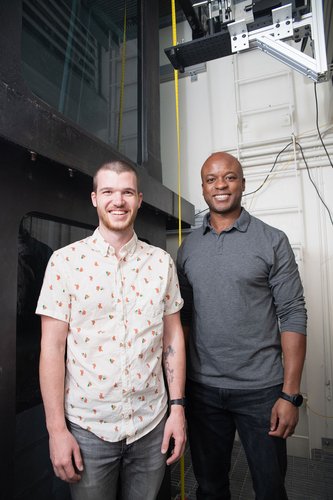The institute has researched how to augment live jellyfish with electronics that enhance their swimming and with a prosthetic “hat” that can carry measurement technology and make the jellyfish more streamlined. The goal is to use jellyfish as robotic data-gatherers, sending them into the oceans to collect information about temperature, salinity and oxygen levels, all of which are affected by Earth’s changing climate.
The work, published in the journal Bioinspiration & Biomimetics, was conducted in the lab of John Dabiri (MS ’03, PhD ’05), centennial professor of aeronautics and mechanical engineering at Caltech, and builds on his previous work augmenting jellyfish. Funding for the research was provided by the National Science Foundation and the Charles Lee Powell Foundation.
“It’s well known that the ocean is critical for determining our present and future climate on land, and yet, we still know surprisingly little about the ocean, especially away from the surface,” Dabiri commented. “Our goal is to finally move that needle by taking an unconventional approach inspired by one of the few animals that already successfully explores the entire ocean.”
Throughout his career, Dabiri has looked to the natural world, jellyfish included, for inspiration in solving engineering challenges. This work began with early attempts by Dabiri’s lab to develop a mechanical robot that swam like a jellyfish. The research team chose jellyfish due to their ability to easily journey to the depths of the oceans in a way that humans cannot. According to Dabiri, a jellyfish also has the most efficient method for traveling through the water of any living creature. However, though his research team succeeded in creating such a robot, that robot was never able to swim as efficiently as a real jellyfish. At that point, Dabiri asked himself, why not just work with jellyfish themselves?

“Jellyfish are the original ocean explorers, reaching its deepest corners and thriving just as well in tropical or polar waters,” Dabiri said. “Since they don’t have a brain or the ability to sense pain, we’ve been able to collaborate with bioethicists to develop this biohybrid robotic application in a way that’s ethically principled.”
Previously, Dabiri’s lab implanted jellyfish with a kind of electronic pacemaker that controls the speed at which they swim. In doing so, they found that if they made jellyfish swim faster than the leisurely pace they normally keep, the animals became even more efficient. A jellyfish swimming three times faster than it normally would uses only twice as much energy.
However, this time, the research team went a step further, adding what they call a ‘forebody’ to the jellies. These forebodies are like hats that sit atop the jellyfish’s bell (the mushroom-shaped part of the animal). The devices were designed by graduate student and lead author Simon Anuszczyk, who aimed to make the jellyfish more streamlined while also providing a place where sensors and other electronics can be carried.
“Much like the pointed end of an arrow, we designed 3D-printed forebodies to streamline the bell of the jellyfish robot, reduce drag and increase swimming performance,” Anuszczyk said. “At the same time, we experimented with 3D printing until we were able to carefully balance the buoyancy and keep the jellyfish swimming vertically.”
To test the augmented jellies’ swimming abilities, Dabiri’s lab undertook the construction of a massive vertical aquarium inside Caltech’s Guggenheim Laboratory. Dabiri explains that the three-story tank is tall rather than wide because researchers want to gather data on oceanic conditions far below the surface.
“In the ocean, the round trip from the surface down to several thousand meters will take a few days for the jellyfish, so we wanted to develop a facility to study that process in the lab,” Dabiri continued. “Our vertical tank lets the animals swim against a flowing vertical current, like a treadmill for swimmers. We expect the unique scale of the facility – probably the first vertical water treadmill of its kind – to be useful for a variety of other basic and applied research questions.”
Swim tests conducted in the tank show that a jellyfish equipped with a combination of the swimming pacemaker and forebody can swim up to 4.5 times faster than an all-natural jellyfish while carrying a payload. The total cost is about US$20 per jellyfish, Dabiri stated, which he found made biohybrid jellies an attractive alternative to renting a research vessel that can cost more than US$50,000 a day to run.
“By using the jellyfish’s natural capacity to withstand extreme pressures in the deep ocean and their ability to power themselves by feeding, our engineering challenge is a lot more manageable,” Dabiri said. “We still need to design the sensor package to withstand the same crushing pressures, but that device is smaller than a softball, making it much easier to design than a full submarine vehicle operating at those depths. I’m really excited to see what we can learn by simply observing these parts of the ocean for the very first time.”
Dabiri asserts that future work may focus on further enhancing the bionic jellies’ abilities. Right now, they can only be made to swim faster in a straight line, such as the vertical paths being designed for deep ocean measurement. But further research may also make them steerable, so they can be directed horizontally as well as vertically.
To see Caltech’s full video exploring the study, click here.
For more of the top insights into automated ocean monitoring, read Meteorological Technology International’s exclusive feature, “What do new international regulations mean for automated ocean monitoring?”, here.



